
|
Sale 28
Pre-Long Beach Coin Auction
| U.S. Gold - Territorial & California |
| |
| |
| Lot |
Photo |
Description |
Realized |
Lot 2092 |
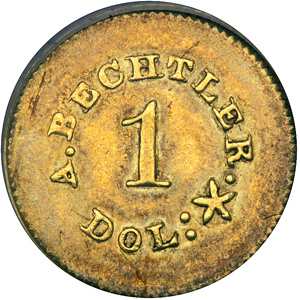 |
August Bechtler, 1 DOLLAR CAROLINA, 27 gr. 21 carats. . K-24, Rarity-3. PCGS graded AU-50. Sharpness finer than the assigned grade but probably net graded by PCGS due to some scattered scuffs in the fields. Subdued greenish gold coloration. Some waxy crud is noted in the letters of CAROLINA GOLD and 27. Not only was the Bechtler family one of the most prolific producers of private gold coinage on the eastern seaboard but they also were skilled watchmakers and even experimented with the production of cutting edge firearms. The long run of gold coins produced by this firm was supplied by the gold found in the Piedmont region of North Carolina and Georgia, a gold rush eclipsed by the magnitude of the 1848 California Gold Rush. A sharp example from a firm held in high regard by the community of its day.
Estimated Value $1,500 - 1,800.
View details and enlarged photos
| Realized
$2,300 |
Lot 2093 |
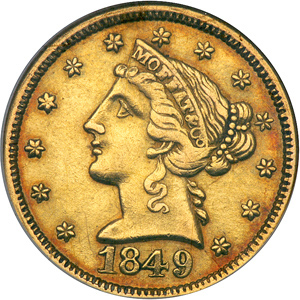 |
1849 Moffat & Co. (San Francisco) $5 Gold. NGC graded MS-61. One of the most significant private coiners of the California Gold Rush, Moffat and Company produced coinage of multiple denominations in large quantities. Due to their popularity and trusted reputation, their gold coinage was heavily circulated and few uncirculated specimens exist of any of the denominations. The surfaces of this elusive piece are rich greenish gold with accents of a delicate reddish orange. The luster is still heavy and strike weakness is noted only on several curls of Liberty's hair and the claws of the eagle. With regards to abrasions, only some trivial hairlines are noted. An important survivor from Moffat and Company, one of the most significant private coinage firms of the Wild West! NGC population of 3 in MS-61, 7 in MS-62, 1 in MS-63, 2 in MS-64, 1 in MS-65 and a single MS-67 as finest.
Estimated Value $7,500 - 8,500.
View details and enlarged photos
| Realized
$8,338 |
Lot 2094 |
 |
1850 Moffat & Co. (San Francisco) $5 Gold. PCGS graded VG-10. Extensively circulated but still retaining the greenish gold coloration expected and an ample amount of detail. Moffat & Co. was a prolific producer of gold coins from 1849-1850 and their reputation was strong as they were known for having the highest purity coins. These pioneer issues were definitely workhorse coins used heavily in the bustling economy of the Gold Rush Era. The melting of a high number of these issues for use in Federal coinage makes any survivor a significant one. A nice "pocket piece" that has retained enough detail and eye appeal to be quite desirable (PCGS # 10243) .
Estimated Value $600 - 750.
View details and enlarged photos
Check results on similar lots
| Realized
$1,438 |
Lot 2095 |
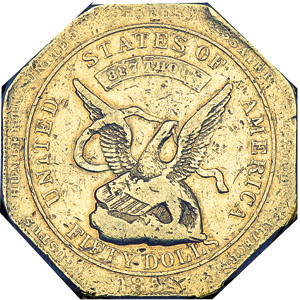 |
1851 U.S. Assay Office $50 "slug", 887 THOUS. Reeded edge. PCGS graded EF-40. Greenish gold surfaces with an even scattering of the expected abrasions. A true workhorse issue from a time when the pure need for coinage meant any example would circulate heavily. The present example survived without picking up any huge rim dings or gouge marks. Feather and shield detail is sharper than normally seen for the assigned grade. A very pleasing example and let's face it. everyone who can afford one, should own at least one!
Estimated Value $13,000 - 15,000.
View details and enlarged photos
| Realized
$16,675 |
Lot 2096 |
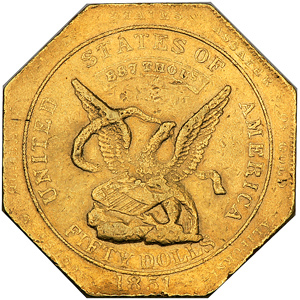 |
1851 U.S. Assay Office $50 "slug", 887 THOUS. Reeded edge. Sharpness of Extremely Fine. Light golden surfaces with a frosty texture. Feather detail and neck detail are sharp. The device of the eagle, shield and rocks have been spared any jarring nicks and this adds heavily to the eye appeal of this piece. A patch of old tick marks are located above the head of the eagle, just below "887 Thous". Often found with heavy rim bruising, this choice "slug" has great rim detail on both obverse and reverse, not a single ding being mentionable. The interwoven circles on the reverse are bold and display choice luster radiating outwards from the center. A choice example and seldom seem this nice in the Very Fine to Extremely Fine grade range.
Estimated Value $10,000 - 12,000.
View details and enlarged photos
| Realized
$16,675 |
Lot 2097 |
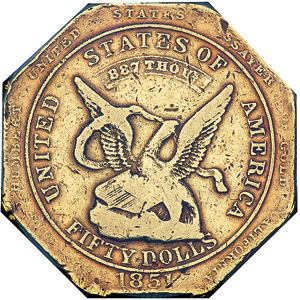 |
1851 U.S. Assay Office $50 "slug", 887 THOUS. Reeded edge. PCGS graded VF-30. A moderately abraded example that has its visual appeal elevated by soft reddish orange toning. There is nothing wrong with a VF example possessing these marks, for a coin this large had no choice but to pick up the observed nicks and dings as it passed through the "frontier" economy of the Gold Rush Era. Several rim dings are seen around the coin and the sharpest nicks are one over the first A of ASSAYER and another near the bull's-eye of the reverse. The crusty reddish orange toning gives a nice look of originality. Anyone looking for a nice circulated "slug" would do just fine by acquiring the present example.
Estimated Value $9,000 - 11,000.
View details and enlarged photos
| Realized
$12,075 |
Lot 2098 |
 |
1852 U.S. Assay Office $10 Gold, "884". NGC graded AU-53. Light greenish gold surfaces with the expected abrasions and hairlines. Wear from circulation is contained to the tips of the wings, eagle's neck and eagle's breast. The only sharper hit is an old nick right of the 2 in the date. These issues were produced for a reason and circulation was definitely in the cards of most of these that were struck. The U.S. Assay Office had the role of "normalizing" barter and commerce in this region by providing assay services and producing coinage that were more consistent, reliable and more heavily favored by the public (at the expense of previous dealers and bankers profit margins). A pleasing AU example from a firm that was the foundation for the San Francisco Mint that opened in 1854.
Estimated Value $4,500 - 5,500.
View details and enlarged photos
| Realized
$5,175 |
Lot 2099 |
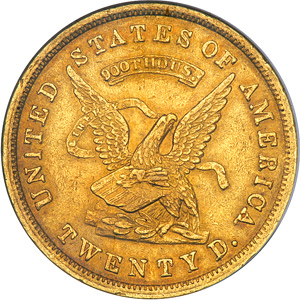 |
1853 Assay Office $20 Gold "900". NGC graded AU-58. A near-uncirculated example with luster that radiates from the central portion of both obverse and reverse all the way to the peripheries. Deep straw coloration and a satiny texture are just a few of the pleasing characteristics of this U.S. Assay issue. A well struck example with the feather, shield and breast detail nearly completely defined. Above average with regards to abrasions and enhanced by soft hints of magenta toning. Of the two major varieties for the 1853 U.S. Assay Office $20, the "884" and "900", the "900" is seen much more frequently. Therefore this coin presents the perfect opportunity to acquire a very choice AU "type" example of a U.S. Assay Office $20. NGC population of 24.
Estimated Value $4,500 - 5,500.
View details and enlarged photos
| Realized
$6,613 |
Lot 2100 |
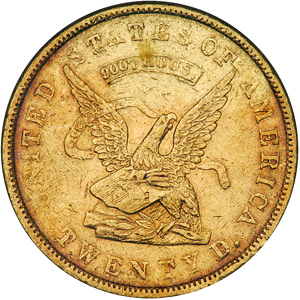 |
1853 U.S. Assay Office $20 Gold, 900 THOUS. NGC graded AU-55. Well struck with crisp luster. The surfaces were cleaned at some point and now are a brighter greenish gold coloration. A scratch is found just underneath the NIT of UNITED and a reed mark lays in the center of the shield. A rim ding is noted at 5:00 on the obverse. NGC population of 16.
Estimated Value $4,000 - 5,000.
View details and enlarged photos
| Realized
$4,600 |
Lot 2101 |
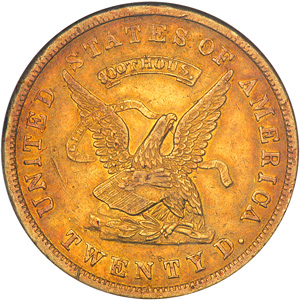 |
1853 Assay Office $20 Gold, 900 THOUS. NGC graded AU-55. Deep gold surfaces with strong magenta highlights. Well struck and very appealing with regards to detail. Were it not for a few random scratches this would be a definite candidate for the next grade level. A scratch exists under the NI of UNITED, the FOR of CALIFORNIA and right of the legend. Two small rim bruises are found at 9:00 on the obverse and 11:00 on the reverse. NGC population of 16.
Estimated Value $4,000 - 5,000.
View details and enlarged photos
| Realized
$5,175 |
Lot 2102 |
 |
1853 Assay Office $20 Gold, 900 THOUS. NGC graded AU-55. Rich yellow gold coloration with a touch of magenta toning in the obverse/reverse periphery and reverse lettering. Luster is still visible rolling around the surfaces and distracts the viewer from the light hairlines that exist. A short vertical tick is observed at the top of the eagle's left wing. While the rims display no bruising, there are some short rim ticks scattered from 8:00-11:00 on the obverse. This is the last year that the U.S. Assay Office produced coinage and the following year marks the beginning of production of coinage by the San Francisco Mint. NGC population of 16.
Estimated Value $4,000 - 5,000.
View details and enlarged photos
| Realized
$4,888 |
Lot 2103 |
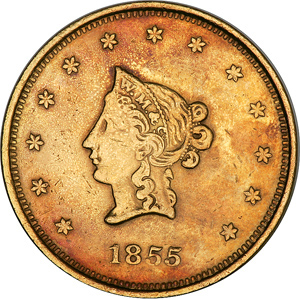 |
1855 Wass, Molitor & Co. (San Francisco) $20 Gold. Small head. . Kagin-7, H.R-6. EF-45. A sharply struck example of this scarce type. An example that has eye appeal and technical qualities bordering AU. All rim detail is full with no bruising or nicks. The surfaces of this example were cleaned many years ago. While hairlines are still visible, they are soft and mostly hidden by magenta toning on the obverse. Reverse surfaces are a more uniform rich gold color with a lightly filmy look. Underneath the eagle's right wing is a small pit which could be a small planchet defect. Far superior than the heavily abraded examples that are normally encountered. We highly recommend interested parties take a close look at this piece! Finer than the example that recently sold for $19,550 at Heritage's 2004 Pittsburgh ANA Sale (Lot #7824)
The distance from the lower point of star 6 to the tip of Liberty's coronet is approximately 2.0 mm. The distance from the recessed area between the lower two curls to the left most point of star 11 is approximately 6.7 mm. A fine die crack connects the lower letters of DOL.
Estimated Value $25,000 - 30,000.
View details and enlarged photos
| Realized
$24,150 |
Lot 2104 |
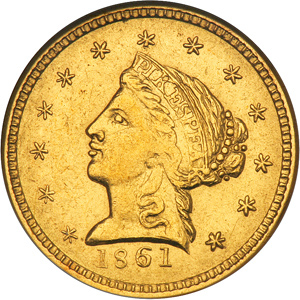 |
1861 Clark, Gruber & Co. (Denver, Colorado) $2.50 Gold. NGC graded AU-58. A trifle softly struck up in the centers as made with smooth matte like surfaces throughout. An attractive specimen free from rim bruises and serious scratches worthy of note. Struck in what was known as the Jefferson Territory (Colorado) in very limited quantities. Experts quote the mintage at about 6,920, but as with other Pioneer gold coins, many saw extensive circulation and many were melted and turned into federal gold coinage. On April 16, 1863 the federal government purchased the Clark-Gruber & Co. firm with all of its equipment which eventually became the Denver mint. NGC reports 8 in this grade with 1 in MS-60, 3 in MS-61, 6 in MS-62, 1 in MS-63 and 1 in MS-64. One can be certain these figures represent some duplication.
Estimated Value $6,500 - 7,000.
View details and enlarged photos
| Realized
$10,925 |
Lot 2105 |
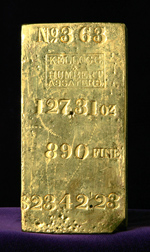 |
(1857) Kellogg & Humbert gold bar No. 363. 127.31 oz .890 Fine gold, value at time of issue $2342.23. A monumental and highly desirable gold bar from the S.S. Central America shipwreck. This treasure bar is a deep yellow gold and is quite lustrous with few traces of red oxidation. The lower right corner has been chipped away for assay purposes by the makers as on all genuine bars. As with other bars from these makers, the serial No. 363 is stamped on the otherwise blank back of the bar. This particular bar is plated in Q. David Bowers A California Gold Rush History on page 435.
An impressive large bar that would be the center of any numismatic gold collection. This bar is accompanied by the special leather edition of Q. David Bowers A California Gold Rush History.
Estimated Value $90,000 - 110,000.
View details and enlarged photos
| Realized
$103,500 |
Lot 2106 |
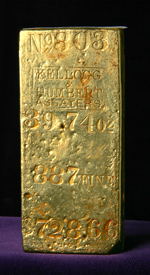 |
(1857) Kellogg & Humbert gold bar No. 803. 39.74 oz .887 Fine gold, value at time of issue $728.66. A wonderful gold treasure bar and a very desirable example from these assayers of the California Gold Rush era. The bar itself is a deep yellow gold in color with the lustrous surfaces exhibiting dark red oxidation in the protected areas. This being a result of the coal from the steamer laying next to the cachet of bars at the bottom of the sea. The lower right corner has been chipped off for assay purposes, a feature on all genuine gold bars of the era. Also we note the control number of the bar No. 803 is also stamped on the back of the bar. This particular bar is plated in Q. David Bowers A California Gold Rush History on page 435.
This bar is accompanied by the special leather edition of Q. David Bowers A California Gold Rush History and the new owner will doubtless spend many hours discussing the epic tales of the discovery of gold in California, and the tragedy of the loss of life on the Central America wreck. Truly a fantastic historical relic which will be the centerpiece of a gold coin collection.
Estimated Value $50,000 - 60,000.
View details and enlarged photos
| Realized
$57,500 |
Lot 2107 |
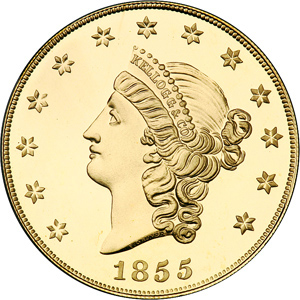 |
1855 Kellogg & Co. (San Francisco) $50 Gold Commemorative Restrike. PCGS graded Gem Proof. Struck in San Francisco September 4, 2001. These huge gold coins were struck from transfer dies made from the original 1855 Kellogg and Company dies. The planchets were made from original Kellogg and Humbert assayers gold ingots recovered from the S.S. Central America treasure. This coin has a stamp on the reverse above the eagle showing "Struck September 4, 2001. C.H.S." (California Historical Society). This coin also bears an inscription "S.S. Central America Gold, C.H.S." on the reverse ribbon. This coin is listed in the Guide Book on page 299.
This coin comes with a custom hand-hammered copper frame with gold imprinted purple ribbons -- modeled after the San Francisco Jewelers Shreve & Co., for the famous 1915-S Panama-Pacific commemorative coins, and all is housed in a custom box.
Less than 5000 of these coins were minted in 2001 and they have retailed for $5000. The original 1855 $50.00 round Kellogg & Co. coin sells in excess of $150,000 when available. A truly historic commemorative coin struck from the actual gold recovered from the S.S. Central America ship wreck.
Estimated Value $2,000 - 2,500.
View details and enlarged photos
| Realized
$3,335 |
Lot 2108 |
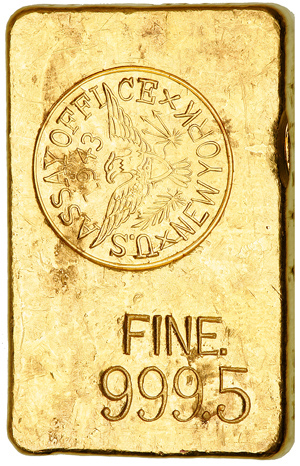 |
1943 United States Assay Office in New York. 11.24 ounces. 999.5 fine. Receipet # 967 9, lot #400. AU-50. A large ingot with fantastic eye appeal. Every element punched clearly and deeply into the gold. The fineness stamp is extremely frosty and the impression of the assay office seal seems close to uncirculated in condition. The left edge of another circular assay stamp is seen on the right hand side of the ingot. The lot # stamp is frosty and deeply punched, the 4 being high. There is a space between the 7 and 9 of the bar # stamp. The weight and OZS stamps are perfectly fit onto the right side of the ingot. A very nice example
The obverse bears the Assay Office stamp (counter-clockwise) and has the punch of FINE 999.8. When viewing the obverse, the right side has"OZS 11.24"punched into it and OZS seems small. The top side contains the number 967 9 punched into it. The bottom side possesses 400, the lot number.
Estimated Value $6,500 - 7,500.
View details and enlarged photos
| Realized
$6,900 |
Lot 2109 |
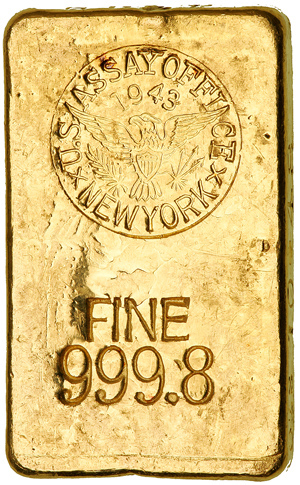 |
United States Assay Office in New York. 10.48 ounces. 999.8 fine. Receipt #14799, lot # 1. AU-50. Once again, brilliant yellow gold with just a touch richer coloration. Only a few gas bubbles are noted and there is a singular scratch in the central obverse. Elliptical concentric rings and a few ridges on the reverse. The assay office stamp is very well struck and appears mint state. All lettering is delicate and frosty. The 7 of the receipt number is noticeably larger and much more sharply impressed into the gold, perhaps someone thinking "Lucky 7" at the time of production. When reverse down on a flat surface, the obverse will appear concave. A well produced, large size ingot with loads of eye appeal.
The obverse bears the Assay Office stamp and has the punch of FINE 999.8. When viewing the obverse, the right side has"OZS 10.48"punched into it. The top side contains the number 14799 punched into it. The bottom side possesses 1, the lot number.
Estimated Value $6,000 - 7,000.
View details and enlarged photos
| Realized
$8,338 |
Lot 2110 |
 |
United States Assay Office at New York. 11.52 ounces. 999.8 fine. Receipt #15091, lot #D1. AU-50. A large and reflective ingot. Brilliant gold with heavy luster on the reverse. Minor gas bubbles are seen on the obverse, heavier on the sides. The stamp of the fineness appears frosty in the numbers. The U.S. Assay Office stamp is a little high, with just a touch of the circle off the ingot. Some ridges and depressions from the mold are noted on the reverse.
The obverse bears the Assay Office stamp and has the punch of FINE 999.8. When viewing the obverse, the right side has"OZS 11.52"punched into it and OZS seems small. The top side contains the number 15091 punched into it. The bottom side possesses D1, the lot number.
Estimated Value $6,500 - 7,500.
View details and enlarged photos
| Realized
$6,900 |
Lot 2111 |
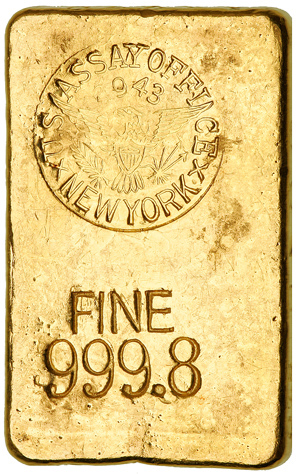 |
1943 United States Assay Office at New York. 9.80 ounces. 999.8 fine. Receipt # 14956, lot #D1. EF-45. Reflective, bright gold with a well defined U.S. Assay Office stamp. Small patches of gas bubbles at the upper right of the assay office stamp and left of the fineness. When placed on a flat surface, the obverse will appear a little concave. A broad and impressive ingot with elongated concentric circles on the reverse.
The obverse bears the Assay Office stamp and the fineness of 999.8. When viewing the obverse, the right side has"OZS 9.80"punched heavily into it. The top side contains the number 14956 punched into it. The bottom side possesses D1, the lot number.
Estimated Value $6,000 - 7,000.
View details and enlarged photos
| Realized
$5,750 |
Lot 2112 |
 |
1968 United States Assay Office at New York. 5.96 ounces. 999.8 fine. Receipt #45453, lot #280. EF-45. Brilliant yellow gold with areas of reflective luster. Some light handling marks in the form of random hairlines are noted on the obverse. Only a few scattered gas bubbles are observed. A rare year and issue with regards to those produced at the New York Assay Office. The United States government officially allowed the price of gold to fluctuate in 1968, ending the fixed price of $35/ounce. While the United States public would not be allowed to privately own gold for another six years, the occurrences of 1968 set up the foundation of what is today's modern precious metals market. A historic and rare ingot in a choice condition
The obverse bears the Assay Office stamp. The reverse bears the fineness of 999.8. When viewing the obverse, the right side has 5.96 stamped heavily into it. The top side contains the number 45453 punched into it. The bottom side possesses 280, the lot number.
Estimated Value $3,500 - 4,000.
View details and enlarged photos
| Realized
$4,025 |
Lot 2113 |
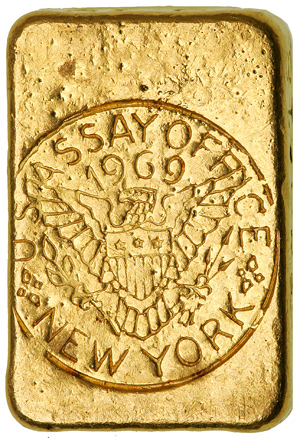 |
1969 United States Assay Office at New York. 6.18 ounces. 999.7 fine. Receipt # 938, lot #R199. AU-50. Another example with brilliant yellow gold surfaces. The reverse has few ridges, most noticeably near the E of FINE. Sharp, reflective luster is seen on the reverse and is quite attractive. The stamp of the U.S. Assay Office is offset a touch to the left. Handling marks are almost not existent and the assay office stamp is bold and deeply impressed. Minor gas bubbles do exist on the obverse. Another issue that is rare with regard to its year of issue and the ingot specialist would be wise to acquire this with the 1968 issue.
The obverse bears the Assay Office stamp. The reverse has the punch of FINE 999.7. When viewing the obverse, the right side has"OZS 6.18"punched heavily into it. The top side contains the number 938 punched into it. The bottom side possesses R199, the lot number.
Estimated Value $3,500 - 4,000.
View details and enlarged photos
| Realized
$4,025 |
Lot 2114 |
 |
Large Gold Nugget, 48.1 gr.
Estimated Value $600 - 800.
View details and enlarged photo
| Realized
$1,150 |
Lot 2115 |
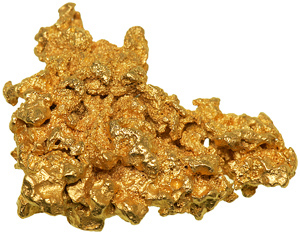 |
Large Gold Nugget, 33.4 gr.
Estimated Value $400 - 600.
View details and enlarged photo
| Realized
$633 |
Lot 2116 |
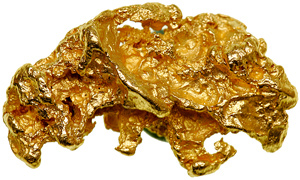 |
Large Gold Nugget, 33.8 gr.
Estimated Value $400 - 600.
View details and enlarged photo
| Realized
$863 |
Lot 2117 |
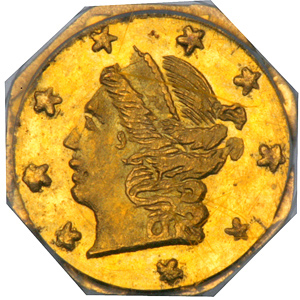 |
1871 Octagonal Liberty Quarter Dollar. . BG-717, Rarity-3. PCGS graded MS-66. An extremely high end example of this quarter dollar issue produced by Frontier & Co. (1864-187½). Liberty is completely frosty and an original deep gold film rests on the surfaces. Die State II. PCGS population of 17 in MS-66 with only 2 in MS-67 as the finest (PCGS # 10544) .
Estimated Value $500 - 550.
View details and enlarged photos
Check results on similar lots
| Realized
$719 |
Lot 2118 |
 |
1870 Octagonal Liberty Quarter Dollar, Rarity-4. . BG-789. PCGS graded MS-64. A scarce and condition census "Goofy Head" example. One of the few "Goofy Head" types that exist. Frosted devices and almost prooflike fields, rare for a Cal Gold piece. PCGS population of 9 in MS-64 with only a single MS-65 known (PCGS # 10616) .
Estimated Value $350 - 400.
View details and enlarged photos
Check results on similar lots
| Realized
$489 |
Lot 2119 |
 |
1854 Octagonal Liberty Dollar. BG-510. Rarity-5. MS-60 Plus. Produced by the firm of Frontier, Deviercy & Co. Mint state survivors of this piece are quite rare. Though this piece does display obverse cleaning, it is confined to the fields and the device of Liberty is frosty and near gem in condition. A pleasing Period I octagonal dollar.
Estimated Value $500 - 700.
View details and enlarged photos
| Realized
$834 |
Lot 2120 |
 |
1852 Octagonal Indian Quarter Dollar. . BG-799 U. PCGS graded MS-64. Brilliant greenish gold coloration with sharp design detail. A few scratches on the cheek are the only marks to point out. The fields are prooflike and offset the frosty devices. A rare subvariety of the BG-799. PCGS population of 11 in MS-64 with 7 in MS-65 as finest (PCGS # 10647) .
Estimated Value $450 - 500.
View details and enlarged photos
Check results on similar lots
| Realized
$633 |
|
|